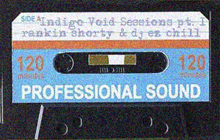OK, now let's try to refine this picture a little bit.
The LinPlug Albino synth has simple, usable FM. The top oscillator can be the ‘shaking’ sound, while the bottom oscillator is the ‘throat’. This feature is sometimes called cross modulation.
To newbies the sound of FM seems to be unpredictable. One moment it’s clear and stable and pure, but if you change the frequency of the ‘hands’ oscillator a little bit, your synth may start growling and screaming. How can you predict what’s coming next? Where's the logic in these seemingly random changes?
In this episode of The Tao of FM the pattern that's hidden in the chaos will be explained a little bit. Just enough to be practical while making music, and of course there will be NO MATHEMATICS ;-)
Right now we’ll look at the simple case of two oscillators. One is the ‘throat’ sound and the other is the ‘hands’ that do the shaking. Careful! If you have two oscillators they can (in theory) shake each other in two different ways. Each sound can be either the ‘throat’ or the ‘hands’. So how do you know which is which?
This is one of the MOST IMPORTANT things in FM and you really need to remember this:
If you turn down the level of the ‘throat’ sound you get silence. If you turn down the level of the ‘hands’ sound you hear the ‘dry throat’ sound without the FM-effect.
Another way of saying this: the level of the ‘hands’ oscillator determines the level of the FM-effect (dry/wet) and the level of the ‘throat’ oscillator is the master level.
This is a basic property of the FM controls and it’s ALWAYS there, in any type of FM-effect and in any FM synthesizer, whether it’s the Ableton Operator, the good old Yamaha TX81Z, the LinPlug Albino, the Native Instruments FM8 etc. etc… That’s why FM becomes a lot easier if you understand the role that each sound (oscillator) has.
 Another way to check which sound is the ‘throat’ and which one is the ‘hands’ is to change the pitch (or frequency) of the oscillators. Usually the fundamental pitch of a sound is changed when you change the pitch of the ‘throat’ oscillator. The timbre of a sound is changed with the pitch of the ‘hands’ oscillator. But sometimes it can be hard to hear the difference. If you’re not sure which is which, it’s better to check by changing the level (volume) of an oscillator.
Another way to check which sound is the ‘throat’ and which one is the ‘hands’ is to change the pitch (or frequency) of the oscillators. Usually the fundamental pitch of a sound is changed when you change the pitch of the ‘throat’ oscillator. The timbre of a sound is changed with the pitch of the ‘hands’ oscillator. But sometimes it can be hard to hear the difference. If you’re not sure which is which, it’s better to check by changing the level (volume) of an oscillator. OK, let’s move on to the last crucial thing you really need to know about FM if you want more predictable results. It's the thing that can really screw with your head if you don’t recognize the pattern: those seemingly random changes in timbre you get when you change the pitch of the ‘hands’ oscillator.
If you listen again to the example from episode 1 you’ll be able to notice two important things:
This is a simulation of the absolute minimum number of controls you need for FM. The sliders are not ‘real’ and the timing is a bit shaky but it shows some basics.
1. Again: if you change the pitch of the ‘hands’ or ‘effect’ oscillator it’s actually the timbre of the sound that’s affected the most, and NOT the fundamental pitch.
2. The sound that’s created with a certain setting of the controls is THE SAME when you play different notes on your keyboard. In other words: different notes or pitches played on the keyboard have the same timbre. (Otherwise you wouldn’t be able to play a recognizable melody or tight chords, right?)
So what’s really going on when you change the pitch of the ‘hands’ oscillator? It actually changes
the RATIO between the 'throat' pitch and the 'hands' pitch
Think about this for a moment and let it sink in: there’s a constant relation between the frequencies of the ‘hands’ and the ‘throat’ oscillators over the whole keyboard, and this relation is called RATIO.
Now try to get this: the strange unpredictable mess that’s produced by changing the 'hands' oscillator's pitch (or actually the ratio) has something to do with the kind of relation between the 2 pitches.
Now get ready for the final secret, the order in the chaos, the method in the madness:
If the ratio between the 'throat' sound and the 'hands' sound is simple, you get pure and stable sounds. More complicated ratios produce more complicated, unstable sounds.


Some FM synths actually have a control called RATIO (not all synths unfortunately!) so now you know what that does: it changes the relation between the pitches of the oscillators. Again: this relation is valid for any key you actually play on your keyboard and if the ratio is changed the sonic character or timbre of the sound is changed.
If the ratio is simple… wait… What does that mean? Which ratios are simple, and which ones are not so simple? Here are a few quick examples to get you started. See if you can recognize the pattern.
Example ratio settings in the Native Instruments FM8. Not every FM synth has a control that's called 'ratio' which is unfortunate, because ratios are the key to understanding FM
First of all: a RATIO is a NUMBER. Here are some examples of ratios that you can verify in the video:
If the ratio basic sound : effect sound is 1:1 that’s really a bit too simple for music. It means that the basic sound and the effect sound have the same pitch. That’s boring.
If the ratio basic sound : effect sound is moved up to 1:2 it’s still very, very simple. It means the effect sound is twice as high. In other words: it’s exactly one octave higher.
If the ratio is moved up to 1:2,45 it becomes a messy sound because 2,45 is a lot messier than 2;
If the ratio is moved up to 1:3 it’s suddenly a nice and stable sound again because 3 is simple number;
Now move up to 1:3,67 and it has changed into a messy sound again because 3,67 is a lot messier than 3;
Move up to 1:4 the sound is suddenly very simple again, because now the effect sound is twice as high as it was at the setting 1:2 and three times as high as it was at the setting 1:1. In other words: it’s exactly two octaves higher than the basic sound.
And so on and so on. Basically this is the kind of thing that happens all the time when you’re messing around with ratios. Actually the ‘deeper’ pattern in the way the sound changes from stable to rough and back again is always the same, especially for mathematicians ;-)
But for musicians it’s a bit unpredictable and that’s what’s great about FM. It’s full of surprises and even if you know the theory there will always be new timbres and FX to explore every time you start tweaking. But for now the motto is: when you get lost in the FM-jungle you just find the octaves and the simple numbers, and you’ll be OK most of the time.
 The story of the ratios in FM is of course very closely related to the musical theories of Pythagoras, the ancient Greek philosopher who believed that simple ratios are the key to the deepest mysteries of the universe.
The story of the ratios in FM is of course very closely related to the musical theories of Pythagoras, the ancient Greek philosopher who believed that simple ratios are the key to the deepest mysteries of the universe.
















